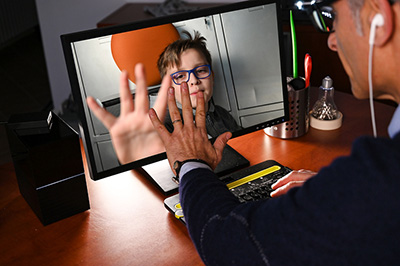Change is difficult. When it comes to education, a student's transition out of a classroom setting and into an online learning environment comes with a unique set of challenges. There is no handbook for educators offering clear information on how to help students through this transition.
However, practicing empathy can help establish productive relationships with students and is an effective way to overcome many obstacles.
The Importance of Empathy
Many teachers already understand the importance of empathetic practice. It is a key to understanding ourselves and those around us.
In the classroom, we practice empathy by listening to our students to understand their situations. This occurs naturally in a traditional classroom, but in an online teaching situation, it might not always be possible to communicate with our students in the ways we would like.
Thankfully, there are many things we can do to hone our ability to empathize. We need to be more conscientious about creating an atmosphere that nurtures relationship-building. Here are some exercises you can practice, putting you on track for employing empathy in an online classroom:

Spark Emotional Participation
- Whether you ask in a chat or video session, check in with your students by asking, "How are you feeling?"
- Let students weigh in throughout your lesson with emojis so you can determine how they are emotionally digesting and reacting to various aspects of the subject matter.
- Encourage them to share their thoughts by asking purposeful questions that are open-ended and elicit deeper thinking.

Provide a Visual
- Requiring students to be on camera during class is arguably the most effective way you can encourage empathy development in your online classroom. It provides an opportunity to view the emotional states of others and activates students’ mirror neurons, enabling them to share the emotions of other students and better understand their circumstances.
- Connecting "face-to-face" with teachers and other students using video and audio allows for a better flow of conversations, during which adolescents can pick up on important psychosocial skills to develop empathy.
- Using video continuously can cause video fatigue for some, but teachers could reasonably request 15 to 20 minutes in each lesson with breaks to ensure this does not occur.
Encourage Interaction
- Allow for break-out sessions or project work groups to let students discuss ideas in a smaller setting. This teamwork approach allows them to hear a variety of perspectives.
- Challenge yourself to creatively incorporate role-playing into the group or classwork. It helps students put themselves in others' shoes and understand more clearly how varying circumstances impact, for example, decision-making.
- On days when technology works against you, encourage phone calls where students can talk with each other about a cooperative task.

Nurture Empathetic Practices
- Provide mindfulness activities, such as guided meditation, and exercises focusing on sounds and sensations happening in the present.
- If a student seems upset, make the time to take him or her aside for an online chat or video call to express your empathy.
- Lead by example. If you express your empathy, your students will feel more comfortable expressing themselves.
- Use a conversational style during the lesson and when giving feedback to improve empathetic interactions.
Know When to be Empathetic
Think of a time when you were empathetic. Using this scenario as an example, answer the following questions:
- What was the situation?
- Who was involved?
- How did you feel?
- What response occurred after you were empathetic?
Sometimes, it's tempting to express empathy without thinking about the entire situation. Remember to think about the following before jumping in:
- Is the individual looking for empathy?
- How would you feel in his or her situation?
- How can you provide empathy?
Asking questions can build your awareness of empathy. It is imperative to take time to reflect before acting. Your actions can be very influential to online learners and their families.
Self-Empathy Plays a Leading Role
Focusing on self-empathy is a wonderful way to start building empathy for others. It starts with analyzing your way of thinking. Taking time to understand your feelings can be beneficial to your students as well. Try these ideas to start practicing self-empathy:
- Write in a daily journal.
- Practice mindfulness techniques such as meditation.
- Pause often to reflect on your feelings.
- Ask yourself questions.
- Connect past experiences to current ones.
Research shows that success in remote learning is dependent on empathetic interactions between the teacher and each student, as well as other class members. Empathy can improve motivation and comprehension in the digital classroom.
 Erika Duso has over nine years of combined online and classroom teaching experience. She is currently a Teacher Facilitator for first-grade math and social studies and assists as a Virtual Liaison for Lincoln Learning Solutions. Erika enjoys backpacking, reading, and looking for rocks in the Great Lakes.
Erika Duso has over nine years of combined online and classroom teaching experience. She is currently a Teacher Facilitator for first-grade math and social studies and assists as a Virtual Liaison for Lincoln Learning Solutions. Erika enjoys backpacking, reading, and looking for rocks in the Great Lakes.




 Erika Duso has over nine years of combined online and classroom teaching experience. She is currently a Teacher Facilitator for first-grade math and social studies and assists as a
Erika Duso has over nine years of combined online and classroom teaching experience. She is currently a Teacher Facilitator for first-grade math and social studies and assists as a